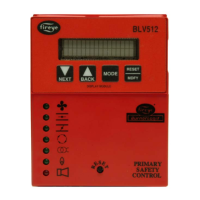© 2023 Carrier 60
Polling intervals are not less than 200 mSec per request. Requesting data such as burner minutes, system
minutes and burner cycles should be kept at a minimum due to the amount of processing time required
to gather that data.
The MSGN being transmitted is a numerical value and must be interpreted by the communicating device, which
is an advantage since this can be made to be whatever message text the end user wants. In other words, it allows
for programming custom messages without actually changing the message in the programmer. Refer to Table
25, for message information.
The BurnerLogix stores its burner on time (7 powered) and system on time (L1 powered) in minutes. For display
purposes, the programmer converts this to hours. The information being supplied by
Modbus will be the actual time in minutes, and it is up to the communicating device to do the conversion. Since
the maximum value stored in the BurnerLogix is 9,999,999 minutes, the maximum value in hex therefore is
98967FH and comprises two data words. The maximum cycle count is 999,999 decimal or F423FH, still two
data words. To convert, multiply high word by 10000H (65536), add to this high byte of low word multiplied
by 100H (256) and add to this the low byte of low word. Example: (98H*10000H) + (96H*100H) + 7FH =
98967FH = 9,999,999 minutes.
As an example, the System on Minutes data is transmitted from the BurnerLogix to the interface as high word
/ low word as shown below: The same applies to Burner On Minutes and Burner Cycles.
All values are represented in a HEX or base 16 format.
GSTAT determines the type of value TIMER represents. TIMER can be a running timer such as is used in purge,
a flame signal or meaningless. Only the lower nibble of GSTAT has any value. If this value is 0 then the TIMER
value has no meaning. The value in TIMER is a background minute timer in the BurnerLogix and should be
ignored. If GSTAT is between 4 and 7, the TIMER represents the current value flame signal. If GSTAT is a 1,
2, or 3 then TIMER represents a running timer value.
The format of the data is 8 data bits, no parity and 1 stop bit. Due to the RS485 format, the communication
format is considered half-duplex. That is, only one user is permitted on the communication lines at a time.
The information contained in INPUTS and OUTPUTS represents the status of the interlocks and output relays
respectively. For the INPUTS, a 1 in the interlock position defines the interlock as being on or active where a
1 in any bit position in the OUTPUT register signifies the relay as being energized.
Table 22: INPUTS AND OUTPUTS
INPUTS (40007)
A ‘1’ in the opto-coupler position indicates the opto-coupler is on or interlock closed.
Note: For YP148/YP184 programmers, Term 21 is LGP input, Term 23 is VPS input, Term W is Ignition,
Term 5 is Pilot, Term 6 is Main Valve 1 and Term 7 is Main Valve 2.

